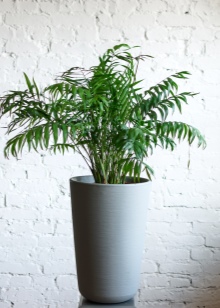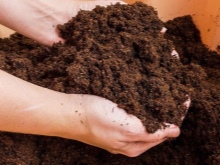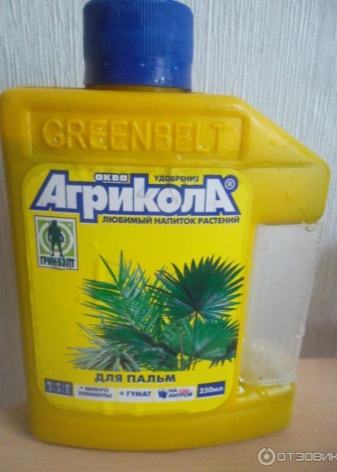Hamedorea graceful: description, care, reproduction

Hamedorea graceful has many names - bamboo, mountain, salon and indoor palm. She fell in love with flower growers not only for its spectacular appearance, but also for its ability to purify the air in the room.
Let's dwell on the description of the features of this unusual flower and tell you how to properly care for it.


Peculiarities
In total, the genus of exotic hamedorei has over 100 varieties that grow in the wooded regions of South and Central America, as well as on the island of Madagascar and in South Africa. In the natural environment, these are mainly lianas or small palms, however, not so many species are adapted for growing in indoor conditions. One of them was the graceful hamedorea, also known as the elegance hamedorea.
This plant has a creeping trunk from which a large number of shoots grow - which is why it is classified as a shrub. Shoots are erect, rather thin, outwardly reminiscent of bamboo. They have a single point of growth, do not branch. The length of the chamedorea reaches 1.8-2 m, in its natural habitat it grows on the lower tier, therefore it does not require good illumination.
The leaves give the plant a decorative look. They consist of 5-7 cirrus leaves of a dark green hue, collected on a tubular petiole in pairs.


Such a palm tree grows extremely slowly - the growth does not exceed 1-2 leaves per stem per year.
A small number of leaves does not in any way impair the decorative appearance of plants., nevertheless, they are most often sold in several pieces in one container - such a composition looks like a leafy, very lush ornamental bush.
Hamedorea, elegant at home cultivation, can bloom: it produces nondescript panicles with spherical yellow flowers, visually resembling mimosa branches. At the end of flowering, round fruits with a diameter of 5-6 cm remain, one seed ripens inside each.


Advice! The flowers of this palm tree do not differ in special grace and beauty, while flowering takes a lot of energy from a green pet. To prevent chamedorea from spending the necessary trace elements for setting and ripening seeds, it is best to pluck the inflorescences at the stage of their formation.
The salon palm tree is spectacular, but at the same time compact. It looks good in any interior, and it can be grown both as an independent plant and as part of a group. It should be noted that chamedorea is not only beautiful, it also brings considerable benefits - it moisturizes and purifies the air from formaldehyde and benzene vapors. The palm tree is non-poisonous, so it can be safely planted in houses where tetrapods and feathered pets live.
Esotericists believe that this unusual plant helps to get rid of sadness and melancholy, maintains optimism and creates a good mood. That's why it is recommended to plant it in the living room or in the kitchen, and it is not recommended to place a palm tree in the bedroom.



Care
A new flower brought from the store should certainly be left in quarantine - it needs time to acclimatize. It should be kept away from other green pets for two weeks after purchase to prevent infestation. - it is possible that chamedorea could catch a disease or some kind of pest in a nursery or store. During this period, the flower needs moderate watering and good lighting.

The soil
The bamboo palm is quite picky about the composition of the soil - to grow this exotic, moisture and breathable soil, loose and fertile, is needed. It is best to take a ready-made soil mixture designed specifically for palm trees, but you can also compose it yourself according to the following recipe:
- turf soil - 3 parts;
- deciduous land - 1 part;
- peat - 1 part;
- river sand - 1 part.
It will not be superfluous to add a few pieces of charcoal or activated carbon to the soil.



Transfer
The transplant should be done a couple of weeks after the acquisition of hamedorea, regardless of the season. From the store pot, it should be transferred by transferring to a larger container, and the resulting voids should be filled with a nutrient substrate.
In the future, the transplant is carried out in the first half of spring: young plants - annually, and palms older than 3 years - every 3-5 years. Old chamedoreas do not need to be transplanted at all - you just need to update them in the upper layer of the substrate (remove the old one and fill in the new one). This should be done every spring.
Please note that when transplanting chamedorea, pebbles, expanded clay or any other drainage should be placed on the bottom of the container so that its height is about 1⁄4 of the height of the container. This will prevent stagnation of moisture and prevent rotting of the root system.


Light
The bamboo palm should not be grown on a windowsill or anywhere else exposed to direct sunlight. The area under the window or to the side of it will be optimal for it. At the same time, shadows must be avoided, this plant needs a well-lit corner.
Hamedorea can grow and develop equally well in both natural and artificial light. The best option is when scattered rays shine on the bamboo palm during the daylight hours. If the chamedorea is located in the corridor or in the very corner of the room, it is worth placing an LED lamp or LED strip near it, it should shine at least 10-13 hours a day.
South-facing apartment owners should make sure that bright rays do not fall on the bamboo palm tree during hot summer hours. - burns leave rather ugly brownish spots on the leaf blades. Therefore, it is best to protect the flower with a small screen or light tulle. In winter, the sun's rays are absolutely harmless, so the hamedorea can be moved closer to the window.


Please be aware that under one-sided lighting, the original symmetry of the palm tree is broken, and the plant loses its attractive appearance... To prevent this from happening, it is necessary from time to time to rotate the container with a palm tree around its axis - for example, every 7-10 days to make a 90-degree turn.
The creation of a favorable temperature background deserves special attention when caring for an exotic. At the stage of active growth, the plant feels comfortable at a temperature of + 21 ... 26 ° С, during the dormant period from December to February, it is advisable to lower the heating to + 16 ... 18 ° С. If this is not possible, then try to move the palm tree away from radiators, fireplaces and any other heat sources.
The minimum permissible temperature is + 12 ... 14 ° C, if the room is colder, chamedorea will quickly die.
This plant is dangerous gusts of wind and drafts, so when ventilating, try to remove them away from windows and balcony doors.


Humidity
Hamedorea is extremely picky about the humidity of the room, which must remain at around 40-60% for the full growth and development of the plant. To maintain the necessary microclimate, it is best to purchase an electric humidifier. Such a device benefits not only flowers, but also all other inhabitants of the apartment, however, such equipment is not cheap.
Alternatively, you can regularly, at least once every 2 days, spray chamedorea from a spray bottle, and once every 2-3 weeks arrange it with a warm tropical shower. Such manipulations allow you to wash off all the settling dust and dirt, as well as refresh the green foliage. It is hardly possible to wash an adult palm tree under the shower - then you can wipe the leaf plates with a damp sponge twice a month. This should be done carefully, using settled or filtered water. Treatment with cleaning agents and wax compounds is strictly prohibited.


In the absence of a humidifier, you can go for a little trick. - put a small indoor fountain next to the flower. Although the evaporating liquid does not increase the humidity level significantly, this method is considered the least effective.
The irrigation regime of hamedorea directly depends on the temperature background in the house and the season. So, in the period from March to the end of October, the plant is actively increasing its green mass - at this time it must be irrigated regularly and quite abundantly. However, try not to allow moisture to stagnate - excessive waterlogging contributes to the appearance of fungi and rot and leads to the death of the plant. The approximate frequency of watering in spring and summer should be 2-3 times every 7-10 days.
With the onset of autumn, watering can be reduced, and starting in November, transfer to 1 irrigation per week, and then only after the top layer of soil in the pot has dried.
Please note that, regardless of the time of year and the frequency of irrigation, the plant needs soft heated water, the temperature of which is 2-3 degrees higher than room temperature.


Pruning
Young Chamedoreans do not need pruning, and adult plants do not need to prune the stems and leaves. Inexperienced growers try to stimulate lateral growth of shoots and cut off the top - this is a big mistake. A palm tree has only one growth point, and when it is cut, the development of the bush simply stops, and new leaves are not formed.
But sanitary pruning must be given attention - as the leaf plates die off, they must be removed so that the yellowed and dried foliage does not impair the decorative appearance of the plant. When carrying out manipulations, you should adhere to some rules:
- for trimming, only sterile working tools must be used - scissors, knife blades and pruning shears are pre-treated with an antiseptic, for example, alcohol;
- dry areas should be cut off completely, capturing about 1 cm of green tissue;
- the places of the cuts must be treated with any fungicide or sprinkled with crushed charcoal.


The implementation of such simple recommendations will prevent pathogenic microflora from entering healthy tissues.
Like all other palms, chamedorea loves fertilizer. The most effective are ready-made complexes of the brands Agricola, Chisty List, Florovit, Bona Forte, Mister Tsvet and Compo. You can use other preparations intended for dracaena, as well as palms, ficuses. From March to November, feeding is carried out 2 times a month, during the rest period from December to February - 1 time in exact accordance with the dosage specified in the attached instructions.


Reproduction
There are several ways to propagate a bamboo palm tree.
- Basal shoots. They are separated from the parent bush in early spring before the start of the active growth stage. To speed up rooting, the shoots are placed in a container with a nutrient substrate, sprayed with water and shaded.
- By dividing the bush. This is not the most common method, as the roots rarely grow long enough at home. This method can only be used for very large, highly overgrown hamedorei.
- Reproduction by seeds. A labor-intensive method that requires patience and some skill. The seeds can be purchased at a specialty store, or you can get it yourself. To do this, manual pollination of chamedorea is carried out - with a soft brush, the pollen of a female plant is collected and transferred to the flowers of a male.Seeds are germinated in a greenhouse, inside which it is necessary to maintain a temperature of + 25 ... 27 ° C and high humidity. Usually the first shoots appear in 2-6 months. After the first full-fledged leaves grow up to 4 cm, the seedlings can be transplanted to a permanent place.


Diseases and pests
If chamedorea is grown in a dry, warm room, then it is often affected by the scabbard, as well as spider mites. In order to get rid of the pest, it is necessary to collect the insects with a sponge moistened with a solution of laundry soap. In case of significant damage, it is better to use the drug "Actellik".
When the tips of the leaf plates dry out, they humidify the air in the room and increase watering. If the plant is in a draft, brown spots appear on it.
Excess moisture causes the leaves to turn gray and withered - when such signs appear, you should temporarily stop irrigation.


See the next video for caring for graceful chamedorea.































The comment was sent successfully.